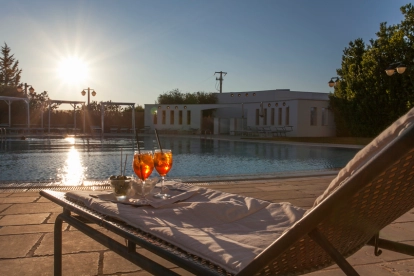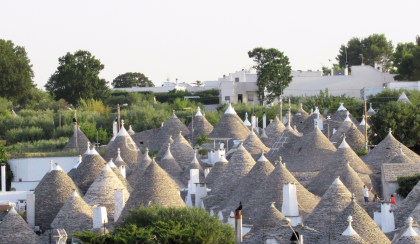Road to Apulia
You will recall our family adventures thus far on our summer journey to the south of Italy (see Road to Apulia 1 if you don’t). Well, from hereon-in our tale steps up a pace as we get down to the business of our Puglia vacation proper. It’s 09.30 in the morning and it has been a relatively short two and a half hour drive from our last night’s hotel at San Giovanni Rotondo and we will soon be approaching Alberobello.
The temperature is rising into the late-thirties as we leave the highway and coastal plains of the Adriatic to climb the olive-tree-clad, craggy limestone hills to an elevation of 300 or 400 metres. We traverse the yellow roads of the countryside through Acquaviva delle Fonti and Putignano. Everything changes in these small towns and villages. The racy 130 kph (140 if no-one is looking) speeds of the autostrada are left behind as we slow to a crawl. Traffic lights seem forever red (although many locals in the south consider them Christmas decorations and ignore them). It appears that at every turn in the road we will be held up by a crusty old Fiat Panda, or hiccupping tractor, both trundling along at under 30 kph.
Best to go with the flow – no chance of rushing – so just accept it. My eldest daughter in the front seat is battling to no avail to distract the youngsters’ attention with off-the-cuff quizzes and drawing competitions. Their chant of: “When will we get there?” is soon replaced by: “Daddy, will we ever get there?”. I’m beginning to believe the backseat trolls are mind-readers.
Hurrah! We’ve arrived! We’re staying as guests of the excellent Grand Hotel la Chiusa di Chietri set in olive-groves just outside Alberobello. This is one of those places that has the got the balance just right between authenticity and comfort. We use the property for Insight guests and it is always popular. Like my kids, they love its modern facilities, great pool, outdoor lounge at night and excellent kitchens.
Leaving the three little ones at the hotel with their big sister, I hightail it down to Brindisi to pick up my wife and our three-month old baby from the airport.

With no kids on board I can pace it up a little so I’m soon whistling past the agricultural traffic and delivery vans, through busy Locorotondo, and on to the picturesque white walls of Ostuni to then drop back down the steep hillside to rejoin the coastal highway further south.
’m driving right through the heart of the trulli region… so I’d better explain more…
The towns of Putignano, Ostuni and Martina Franca form a ‘trulli-triangle’ that is part of the Itria Valley, in the Murge area of Puglia.
A trullo (the plural is trulli) is a traditional Apulian dry stone hut with a conical roof. Their style of construction is capped by a pinnacolo (central pinnacle) and the buildings are often painted with simple Christian or other symbols.

Trulli were mainly built as shelters and storehouses or, as permanent dwellings by small proprietors or farm workers. Alberobello is the best example, as whole districts of the town contain dense concentrations of trulli, hence its popularity with visitors. The ‘golden age’ of trulli was the late 1800s, which was when the wine trade really developed in the region. Today, trulli are often sought by foreigners who snap them up and renovate to modern standards as holiday homes or rental properties.
With family now collected and gathered at the hotel, we spend an afternoon by the pool and head into Alberobello to explore its labyrinth streets. After taking our fill of the sights and sounds, with a stop in a corner cafe, we retire to Il Pinnacolo, a garden restaurant , to enjoy sunsets overlooking the city’s roofs.
It’s a pretty busy restaurant but we secure a table for all seven of us and the evening’s dining begins. Service is typically slow and relaxed, which is fine and the food is definitely worth the wait.

The thin-crust pizza and steaks were very good (kids’ seal of approval) but for me the best starter in Alberobello is the smoked sword fish and smoked salmon – perfection! Prices are great with a pizza coming in at about four Euros. Compare that to Switzerland. Not likely!
A nice bottle of local Verdeca wine and we’re sorted.

A new day dawns and we enjoy a typically local breakfast with fare that includes delightfully soft and spongy, custard-filled pasticciotto (little cakes), black olives, fresh salad and of course an array of delicious cheeses – including burrata (mozzarella with a liquid centre), ricotta forte (spicy ricotta), and my favourite, scamorza. This last one is a stretched curd cheese, hung to partially dry, and sometimes smoked. It is to die for.
Two strong coffees, pack the car and we’re off. Heading west across the peninsula for six nights in a seaside villa near Pulsano, on the Gulf of Taranto.
More to follow next time!
Footnote: My eldest is vegan but had no problem whatsoever finding suitable dishes wherever we went. While you’ll find amazing meat and fish dishes throughout Puglia, the region used to be very poor, so use of vegetables and simple cooking was always a mainstay. This heritage can still be seen in menu items throughout the region, which makes is a vegetarian or vegan paradise.




